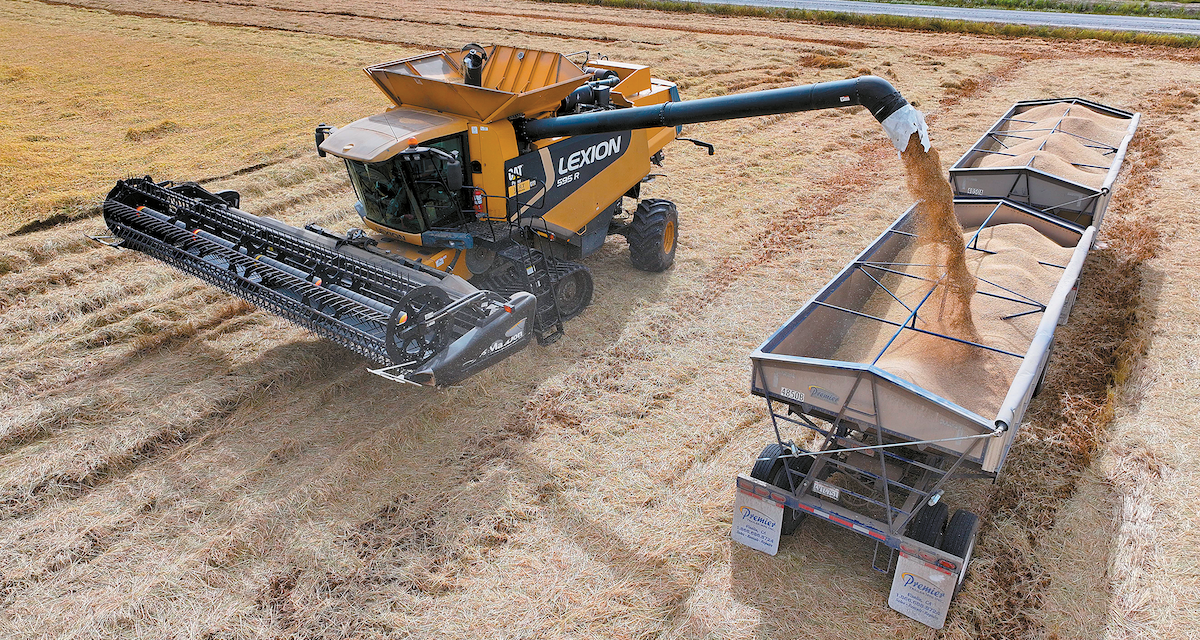California farmers grew 511,000 acres of rice this year compared to 254,000 acres in 2022
By Ching Lee
California Farm Bureau Federation
CALIFORNIA — After idling half the state’s normal rice acreage last year due to water shortages, farmers of the grain are back in full force with harvest underway in the Sacramento Valley.
They’re off to a later start because of planting delays in the spring, which has pushed harvest into the rainy season. Substantial downpours this time of year could cause muddy fields, further delays, and rice plants to fall over, dramatically reducing yields and quality.
With days getting shorter and cooler, the race is on to get the crop off and into mills.
“I’m a little antsy because we’re always worried about rains coming in October and messing up the harvest,” Colusa County grower George Tibbitts said.
Tibbitts did not grow any rice in 2022 and was expected to complete harvest late last week. He said his crop “looked good all year long” and described his yields as 5 percent above average.
Farmers say rain events to date have not been enough to do damage, with growers largely reporting higher yields and crop quality. With most of the carryover inventory sold, they say a full crop is needed to win back markets they could not supply last year.
California farmers grew 511,000 acres of rice this year compared to 254,000 acres in 2022, the lowest since 1958, according to the U.S. Department of Agriculture.
In a typical year, about half the state’s rice crop is shipped overseas, with Japan being the leading importer. South Korea and Taiwan also remain key export markets for California medium-grain rice, which accounts for most of the state’s rice acreage.
After two years of water restrictions and limited planting, Sutter County grower Mike DeWit said “it felt so good to be back” farming all his acreage. The year has not been without hiccups though. Two of his fields are in the Sutter Bypass, which flooded in the spring. He did not get those fields planted until late May, right before the June 1 cutoff date for prevented-planting crop insurance. The delay could push his harvest into the first week of November, which he said he normally wants to avoid.
Despite planting challenges, DeWit managed to sow 100 percent of his acreage. He noted his fields in the Sutter Bypass, which he had not farmed since 2020 due to water restrictions or flooding, look “fantastic.”
“The ground got rested up real good, and it’s producing a wonderful crop right now,” he said. “I’m excited about harvesting (it) when we get there” in another two weeks. Outside of the bypass, DeWit’s other fields are about five to eight days behind schedule, which he said is “not a significant hardship.”
With full plantings and greater yields this year, marketers will have more rice to sell. As such, farmers say they expect market prices will come down from last year’s record highs, which priced some customers out of the market. Still, farmers say they remain optimistic that prices will moderate to levels that allow them to make a profit.
“I don’t foresee a big crash,” DeWit said. “But the price will definitely come down. Everybody knows it. We’re just hoping for a soft landing.”
Erin O’Donnell, vice president of sales at Sun Valley Rice in Colusa County, said rice growers have been through other drought years and reduced water deliveries to farm, but until last year, never had state rice acreage dropped below 400,000. The tiny 2022 crop meant marketers “had more demand than supply,” she said, noting the company was forced to turn away customers and set limits on others it has worked with for years.
“We certainly did lose market share, because we had such little rice last year,” she said. “As a salesperson, you never like to say no to anybody, but we just didn’t have as much rice as we needed.”
Yuba County grower Charley Mathews Jr., who serves as board chairman of Farmers’ Rice Cooperative, which processes and markets 25 percent of the state’s rice, said price-sensitive markets such as the Middle East, which did not buy much California rice last year because it was so expensive, “come back into play” now that “we’ll be price competitive.”
O’Donnell agreed, saying with prices stabilizing, she expects the industry “will be able to win back” customers it lost, such as those in the Middle East, which remains an important export market for California medium-grain rice.
“We’re working together with our long-term customers to help get them the new crop shipments quickly and to bring back their customers as well,” she said, noting Sun Valley hosted a tour recently that brought distributors out to fields “to get them excited about the California rice harvest.”
Carissa Lee, who procures rice for Sun Valley, said the rice market remains uncertain where it will land after reaching record-high prices last year.
“Obviously, (prices) have to come down from that,” Lee said. “The question has been, well, how far does it need to come down?”
USDA reported September pricing at $26 per hundredweight, down from $29 in August “based on a larger California harvested area forecast.” Prices were $36 per cwt. at the same time last year.
With exports to Japan and South Korea just starting, not much has been sold to facilitate much price discovery, though Mathews described the early pricing as “a good sign.” At $26 per cwt., it should still leave some profit margin for growers, “even though this was a very expensive crop” to grow due to higher input costs.
More rice being harvested will benefit not only markets that consume the rice, but it will provide more chow for the millions of birds that use California rice fields as a rest stop to fuel up during their fall migration through the Pacific Flyway.
Tim Johnson, president and CEO of the California Rice Commission, said increased acreage provides ecosystem benefits for numerous species.
“This rice harvest is especially important for wildlife, with every planted and harvested rice acre doubling as invaluable habitat for 230 different wildlife species that rely on rice fields for food, a safe space to rest, nest and raise their young here in the Sacramento Valley,” Johnson said in a statement.
Tibbitts said the reduced rice acreage last year negatively affected other field crops such as wheat and alfalfa, which were ravaged because the birds had nowhere else to go. He noted one of his neighbors lost an entire wheat field to visiting geese, which devoured the crop.
“Since we’re back to full production with rice, we can accommodate all the birds that normally come through here on their migration path,” he said. “They could have their fill of rice that we leave on the ground, and perhaps there will be less depredation problems on wheat.”
With reservoirs at healthy levels and predictions for another El Niño winter, growers also remain optimistic about the new water year and prospects that there will be water available for growing next year’s rice crop.
“Even if it’s just normal rainfall or maybe even a little bit below,” Tibbitts said, “we’re starting off from such a high point that next year should be good for water supply for agriculture in Northern California.”
Feature Image: A harvester empties rice into a trailer in a Colusa County field. Thanks to a wet winter and spring, California rice acreage rebounded this year, with farmers receiving full water allocations. Reduced water deliveries in 2022 forced farmers to fallow half the state’s normal rice acreage. Photo by Fred Greaves













